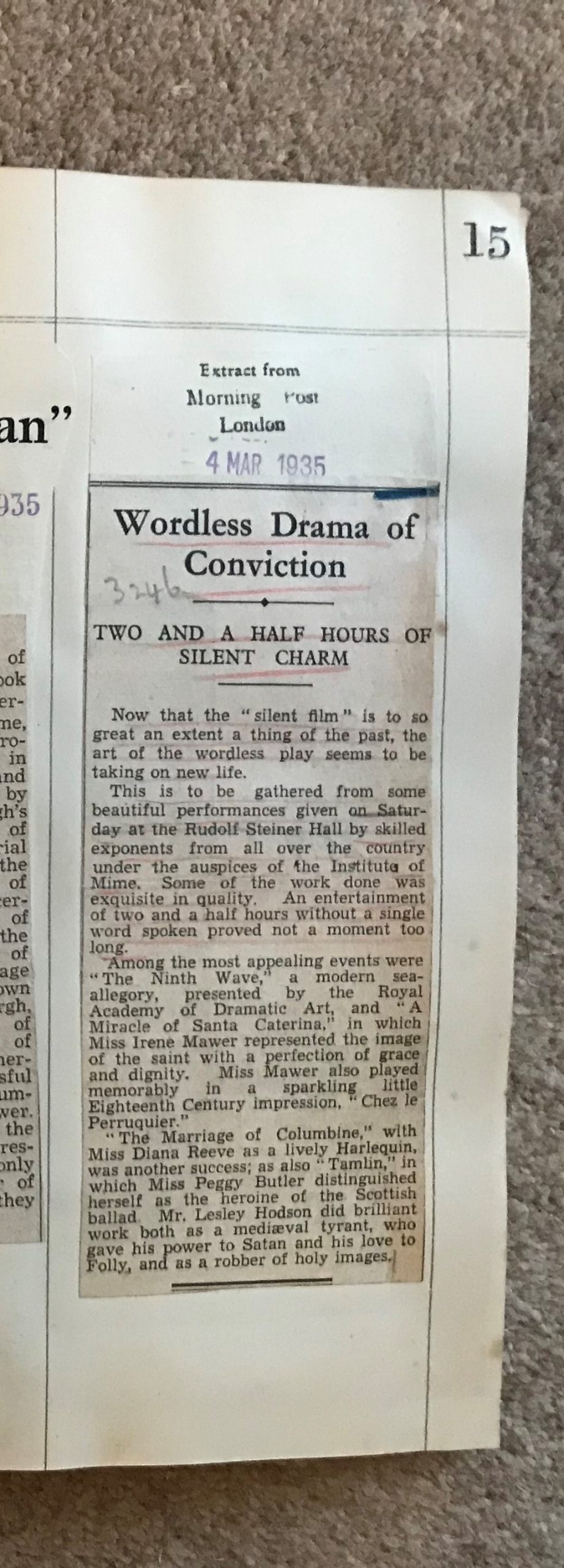Morning Post, London
4 March 1935
Title of Newspaper Article: ‘Wordless Drama of Conviction: two and a half hours of silent charm.’
My comments: Two and a half hours of silent charm! Two and a half hours without any words? That is a l-o-n-g time. That show must have been something special to keep the attention of the audience for that length of time.
This blog post is focused on one of the newspaper reviews of the performance at the Rudolf Steiner Hall in London. The review is glowing, using such terms as skilled exponents; exquisite quality; perfection of grace; memorably; sparkling; lively; another success; distinguished; and brilliant.
Although the newspaper states it was a world of silent charm, I believe there would have been a lot of music. The evening would have been full of sound as well as movement – but not speech.
One of the mime plays presented that evening was ‘The Ninth Wave’ described as a modern sea-allegory, which was performed by students from the Royal Academy of Dramatic Art (RADA). I hadn’t heard of this before and when I looked it up, I found that the ninth wave is on old sailors expression, meaning a single wave which is larger than all of the others, indeed, it is colossal. Apparently, nothing can withstand the power of that huge wave which has built up incrementally after the previous eight. I wonder how the mimes depicted this story? Was it a nature rhythm? Or was it the story of people shipwrecked by the huge wave, as in the painting by Russian artist Ivan Aivazovsky in 1850. In the painting, the survivors of the shipwreck cling to debris which is in the shape of a cross – a Christian metaphor for salvation. This would have fitted very nicely into the type of biblical play that Miss Mawer appreciated.
This religious appreciation was also evident in ‘A Miracle of Santa Caterina,’ in which Irene Mawer played the central role of the saint. I think this must have been one of her favourite plays as she performed the piece on many occasions over the years.
As a total contrast, Miss Mawer also took the title role of the wig maker, or perruquier in the play ‘Chez le Perruqier.’ I have heard of this play before, when the late Ann Cornford told me about it: ‘this was old fashioned, possibly eighteenth century. Miss Mawer was the hairdresser and you could SEE the scissors and the comb. You could SEE the wringlets and the curls as she was working on this person’s hair. She didn’t have any properties, she didn’t use anything – but you could see them. That was her brilliant work with her hands and fingers.’ An accolade, indeed.
And so the evening carried on, with equally pleasing pieces and I wish I could travel back in time to be in the audience.
Thank you for reading. Please share/comment/like, etc, so that the search engines will find Irene Mawer more easily in the future.
